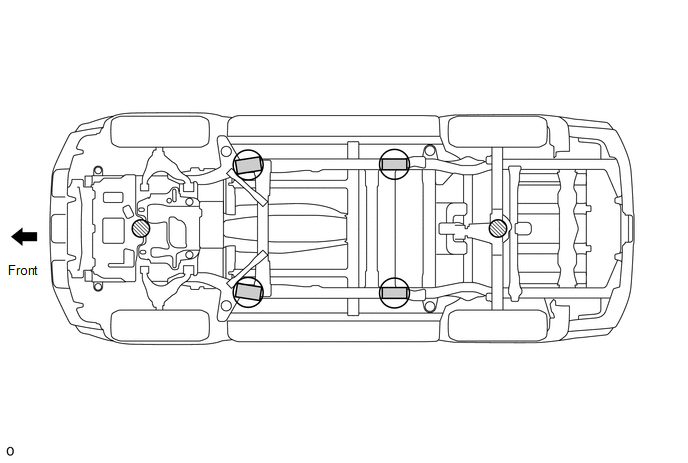Toyota 4Runner: Vehicle Lift And Support Locations
VEHICLE LIFT AND SUPPORT LOCATIONS
1. NOTICE ABOUT VEHICLE CONDITION WHEN RAISING VEHICLE
(a) The vehicle must be unloaded before jacking up or raising the vehicle. Never jack up or raise a heavily loaded vehicle.
(b) When removing any heavy components like the engine or transaxle, the vehicle center of gravity will shift. To stabilize the vehicle, place a balance weight in a location that will prevent the vehicle from rolling or shifting, or place a transmission jack under the appropriate jack position at the opposite end of the vehicle.
2. NOTICE FOR USING 4 POST LIFT
(a) Follow the safety procedures outlined in the lift's instruction manual.
(b) Do not damage the tires or wheels while driving onto the lift.
(c) Use wheel chocks to secure the vehicle.
3. NOTICE FOR USING A SWING ARM TYPE LIFT
(a) Follow the safety procedures outlined in the lift's instruction manual.
(b) Do not interfere with arm in the moving-step.
(c) Be sure to lock the swing arms before raising the vehicle (if equipped with arm locks).
(d) Use the lift to raise the vehicle until the tires are off the ground, then stop the lift and shake the front and rear of the vehicle to make sure that it is stable.
4. NOTICE FOR USING JACK AND SAFETY STANDS
(a) Work on a level surface. Use wheel chocks at all times.
(b) Use safety stands with rubber attachments as shown in the illustration.
(c) Set the jack and safety stands exactly under the specified locations on the vehicle.
(d) Do not work on or leave the vehicle supported only by a jack. Be sure to support the vehicle with safety stands.
(e) When jacking up the vehicle, first release the parking brake and move the shift lever to N.
(f) When jacking up the entire vehicle:
(1) When jacking up the front wheels first, make sure wheel chocks are behind the rear wheels.
(2) When jacking up the rear wheels first, make sure wheel chocks are in front of the front wheels.
(g) When jacking up only the front or rear wheels of the vehicle:
(1) Before jacking up the front wheels, place wheel chocks on both sides of the rear wheels.
(2) Before jacking up the rear wheels, place wheel chocks on both sides of the front wheels.
(h) When lowering a vehicle that only has its front or rear wheels jacked up.

 |
|
CAUTION: When jacking up the vehicle, make sure the vehicle is not carrying any extra weight. |
 |
|
- |
(1) Before lowering the front wheels, make sure wheel chocks are in front of the rear wheels.
(2) Before lowering the rear wheels, make sure wheel chocks are behind the front wheels.
 Precaution
Precaution
PRECAUTION
1. BASIC REPAIR HINT
(a) HINTS ON OPERATIONS
1
Attire
Always wear a clean uniform.
Hat and safety shoes must be worn ...
 Customize Parameters
Customize Parameters
CUSTOMIZE PARAMETERS
1. POWER DOOR LOCK CONTROL SYSTEM (See page )
2. WIRELESS DOOR LOCK CONTROL SYSTEM (w/ Smart Key System) (See page
)
3. WIRELESS DOOR LOCK CONTROL SYSTEM (w/o Smart Key Syst ...
Other materials about Toyota 4Runner:
ECU Initial Setting Incomplete (C120A)
DESCRIPTION
w/ Downhill Assist Control or w/ Crawl Control:
When the master cylinder solenoid (skid control ECU) is replaced, the master
cylinder solenoid (skid control ECU) must be informed that the vehicle is equipped
with downhill assist control and/o ...
Sliding Roof Control Switch Circuit
DESCRIPTION
The sliding roof drive gear sub-assembly (sliding roof ECU) receives sliding
roof switch signals and drives its built-in motor.
WIRING DIAGRAM
CAUTION / NOTICE / HINT
NOTICE:
When the sliding roof drive gear sub-assembly (sliding roof ECU) ...
0.0152
